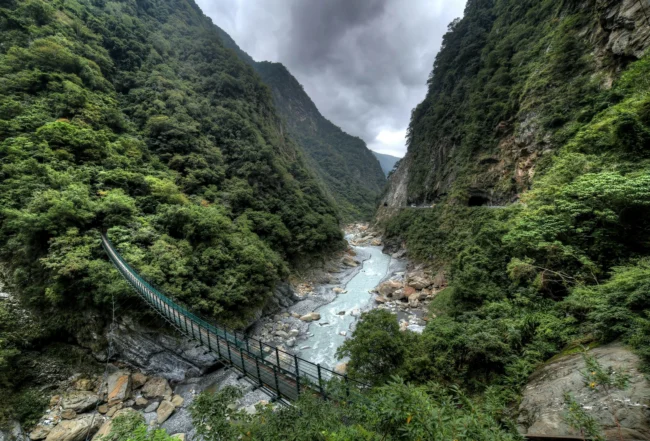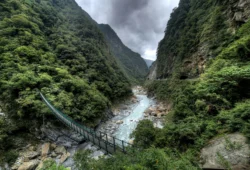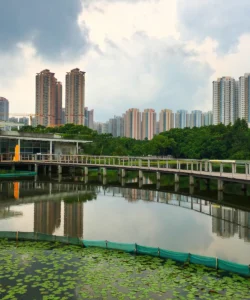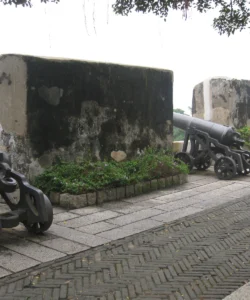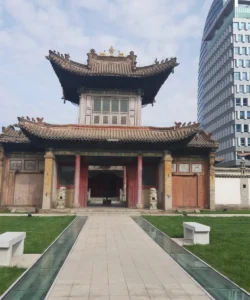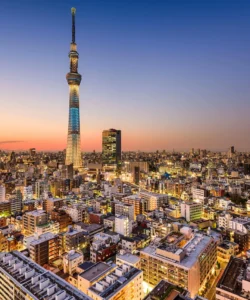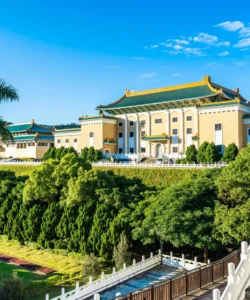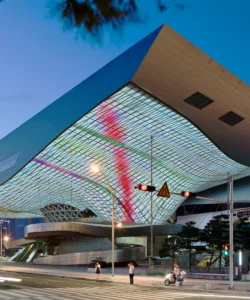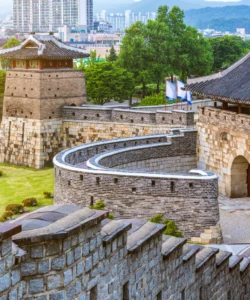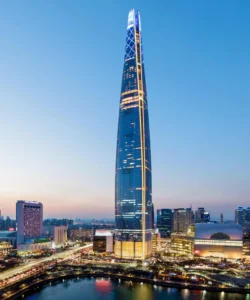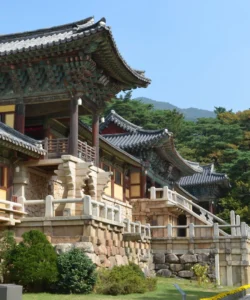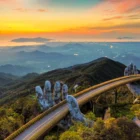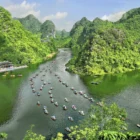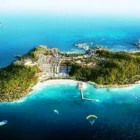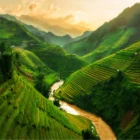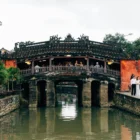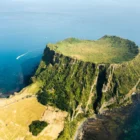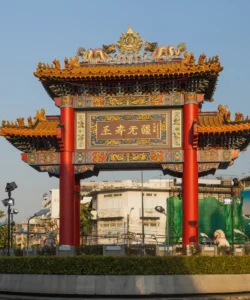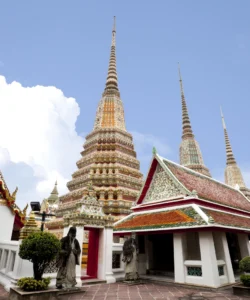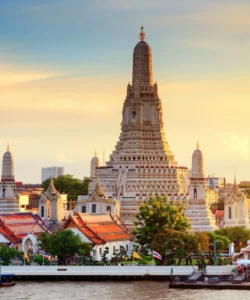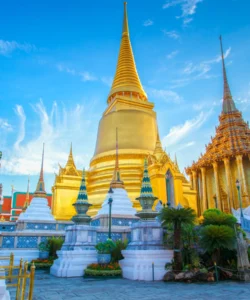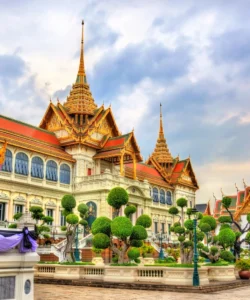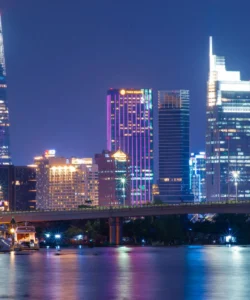Taroko Gorge National Park (太魯閣國家公園, Tàilǔgé Gúojiā Gōngyuán) is one of Taiwan’s most spectacular natural wonders, located on the eastern coast of the island. It is named after the Taroko Gorge, a breathtaking 19-kilometer (12-mile) long canyon carved by the Liwu River through massive marble cliffs. The park, which extends into the Central Mountain Range, is celebrated for its dramatic geological formations, lush subtropical forests, numerous waterfalls, and the unique culture of the indigenous Truku people.
Name: Taroko Gorge National Park (太魯閣國家公園)
Address: Fuxing Village, Xiulin Township, Hualien County, Taiwan. The main visitor center is at the eastern entrance to the gorge.
How to get there:
Taroko Gorge National Park is typically accessed via Hualien City, the largest city on Taiwan’s east coast:
- From Taipei to Hualien:
- Train: This is the most popular and scenic option. Express trains (Puyuma or Taroko Express) from Taipei Main Station to Hualien Station take approximately 2 to 2.5 hours.
- Bus: Buses also connect Taipei to Hualien, taking around 3-4 hours.
- Flight: Domestic flights from Taipei to Hualien are less frequent now but are the quickest option (around 50 minutes).
- From Hualien to Taroko Gorge National Park:
- Taiwan Tourist Shuttle Bus (Taroko Route 310 or 302 e-Bus): These buses depart from Hualien Bus Station (near Hualien Railway Station) and stop at the Taroko National Park Headquarters Visitor Center and various scenic spots within the gorge. A day pass is available.
- Taxi/Private Car: Hire a taxi or private car for a flexible tour of the gorge. Many drivers offer fixed-price day tours.
- Scooter/Motorbike Rental: For independent exploration, renting a scooter in Hualien is a popular way to navigate the gorge’s highway.
- Organized Tours: Numerous day tours from Hualien (or even Taipei) are available, covering the main attractions.
Landscape and Architecture:
Taroko Gorge National Park’s landscape is a dramatic testament to the powerful forces of geology and erosion, with unique natural and engineered features:
- Marble Canyon Walls: The defining feature is the sheer, towering cliffs of marble that form the narrow gorge. The Liwu River has carved its way through this hard rock over millions of years, creating incredibly steep, almost vertical walls that display swirling patterns of gray, white, and green marble, often visible from the highway.
- Liwu River: The turquoise-blue Liwu River flows powerfully through the gorge, continuing its work of erosion, creating pools and rapids.
- Tunnels and Bridges: The Central Cross-Island Highway (Provincial Highway 8) winds precariously through the gorge, often passing through a series of hand-carved tunnels and dramatic bridges (like the Cihmu Bridge with its distinctive marble lion statues). These engineering feats are an integral part of experiencing the gorge.
- Eternal Spring Shrine (Changchun Shrine): A picturesque memorial temple perched on the side of a mountain, with a waterfall cascading from beneath it. It commemorates the 200 workers who died during the construction of the Central Cross-Island Highway. The shrine’s traditional Chinese architecture is beautifully integrated into the natural landscape.
- Swallow Grotto (Yanzikou): A narrow, winding section of the gorge with high marble cliffs dotted with numerous potholes, once home to swallows (hence the name). A walking trail through tunnels allows close-up views of the marble walls and river.
- Tunnel of Nine Turns (Jiuqudong Tunnel): A famously winding and twisting section of a pedestrian tunnel that offers intimate views of the gorge’s narrowest points and the river’s erosive power. (Note: Due to recent earthquake damage, some sections like this may be closed or have limited access as of mid-2025, so checking current conditions is vital).
- Qingshui Cliff: Located just south of the gorge entrance, this majestic cliff plunges almost vertically into the Pacific Ocean, offering breathtaking coastal views where green mountains meet the turquoise sea.
- Indigenous Truku Villages: The park is also home to the indigenous Truku (Taroko) people, and visitors can learn about their culture at places like Buluowan Recreation Area.
What makes it famous:
Taroko Gorge National Park is famous for:
- World’s Largest Marble Canyon: It is renowned as one of the few and most spectacular river-carved gorges in the world cut entirely through pure marble.
- Dramatic Scenery and Grandeur: Its towering, sheer marble cliffs, deep valleys, and rushing turquoise river create a landscape of immense beauty and raw natural power.
- Engineering Marvel (Central Cross-Island Highway): The highway that traverses the gorge is a significant engineering feat, often considered one of the most scenic and challenging roads in the world, built by hand under perilous conditions.
- Cultural Significance: It’s home to the indigenous Truku people, adding a rich layer of aboriginal culture and history to the natural experience. The Eternal Spring Shrine also commemorates the human cost of building the highway.
- Hiking Trails: The park offers a variety of hiking trails, from easy riverside walks (like Shakadang Trail) to challenging cliffside paths (like Zhuilu Old Trail, which requires a permit and can be partially or fully closed).
- Accessibility: Despite its rugged terrain, the park is relatively accessible via the highway and well-maintained viewpoints, allowing many visitors to experience its grandeur.
Differences from some other wonders:
Taroko Gorge National Park distinguishes itself from other natural wonders and canyons in several key ways:
- Marble as Dominant Rock Type: While other canyons exist globally (e.g., Grand Canyon), Taroko’s fame lies in being a massive gorge carved almost entirely through marble. This gives its cliffs a unique appearance, color, and smooth texture that differs from canyons formed in sandstone, granite, or limestone.
- Integration of Engineering (Highway & Tunnels): The Central Cross-Island Highway, with its numerous hand-carved tunnels and bridges, is not just a way to access the gorge but an integral part of the visitor experience and the park’s story. The raw labor and sacrifice involved in its construction are commemorated, making human ingenuity and perseverance a key aspect of the “wonder,” which is rare for a natural park.
- Active Geological Uplift: Taiwan is a geologically active region, and the continual uplift of the land (several millimeters per year) combined with the rapid erosion by the Liwu River creates a dynamic, ever-changing landscape. This active geological process is a more pronounced feature here than in many other older, more stable canyon systems.
- Subtropical Climate and Lush Vegetation: Unlike arid deserts where many famous canyons are found (e.g., the Grand Canyon’s desert climate), Taroko exists in a subtropical climate, resulting in lush vegetation, dense forests, and numerous waterfalls, creating a different ecological and visual experience.
- Indigenous Cultural Presence: The strong presence and cultural heritage of the Truku indigenous people within the park boundaries add a significant human and cultural dimension that distinguishes it from purely geological parks.
In essence, Taroko Gorge National Park is a breathtaking testament to the raw power of geological forces and human endeavor, offering a unique fusion of stunning marble landscapes, intricate engineering, and vibrant indigenous culture that makes it a truly unparalleled wonder.
